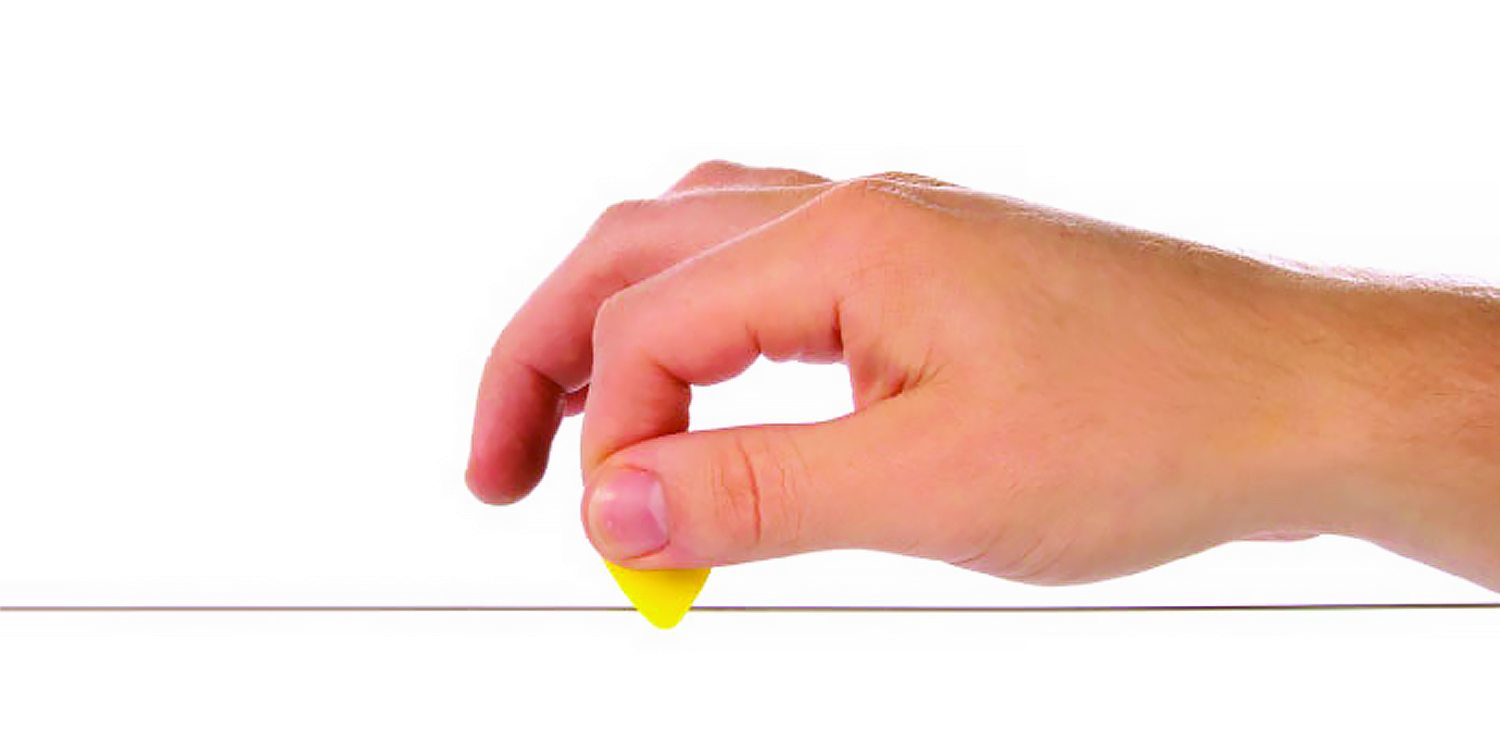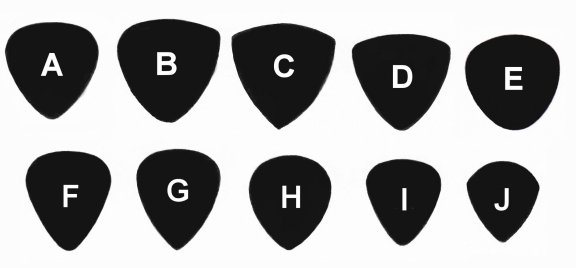
How to hold the pick
Hopefully, you’ve found, bought or borrowed a guitar pick. If not, you’ll need to buy yourself some. Don’t be stingy, go and pick up at least 10 of them – guitar picks are easy to lose (they often don’t cost more than 30 or 40 cents each).
You can experiment with different shapes and brands, but I highly recommend medium gauge picks to start; ones that aren’t too flimsy, or too hard.
The following documentation explains how to hold, and use a pick. When reading, keep in mind that your “picking hand” is the hand which is nearest to the bridge of the guitar, when sitting in the correct position.
1. Open your picking hand, and turn the palm to face you.
2. Close your hand to make a very loose fist. Your thumb should remain beside your index finger.
3. Rotate your hand until you are looking at it’s profile, with your thumb’s knuckle facing you.
Choosing the right guitar pick
1. Thickness
I’ve found after many years of experimentation that for me, the most important factor in choosing a pick is the thickness. As a general rule, a thicker pick will give you more control (which I find better for precise lead playing), and a thinner one has more give (which is better for thicker strings & rhythm playing, or strumming chords).
I find that the higher gauge strings you use, the thinner your pick needs to be – because one or the other has to give in order for the string to vibrate, so as the thickness of your string goes up, the thickness of your pick goes down. Of course, I use a pretty thick pick to begin with, so this is a relative measurement – I use a 2 mm pick for a set of .70-.10 7 string set.
If you’re trying to strum chords on a steel-string acoustic with a 3mm pick, you’re gonna have a bad time. If you’re trying to shred on .08’s with a extra light pick, you’re gonna have a bad time. In both cases, you’ve got the wrong tool for the job. For strumming, you want the notes to blur together a bit, to sound like one sound, not like six distinct sounds one after the other – a nice light pick will mush the sounds together so it sounds like a symphony instead of plink city. For shred, a thick pick will give you the control you need with a stronger attack and more definition of the notes.
As with all of these parameters, you should naturally use whatever feels most comfortable, but it’s imperative that you know what different ends of the spectrum will give you.
2. Shape
Teardrop? Triangle? Rounded? Oblong? What’s each one good for and why? Just like people, picks come in many different shapes and sizes.
The teardrop is easily the most popular shape, mostly due to the need for a point on the end that you hit the strings with (for attack and precision) and a nice round part at the other end (for a comfy grip). But that doesn’t mean it’s the right one for you – Kerry King of Slayer uses great big triangle picks because he is constantly breaking them, so when that happens he can just turn it to the next corner and keep on ripping.
Maybe you don’t want a sharp, hard attack – maybe you want the note to kind of ease itself into being, to subtly slide its way into the song. A more rounded pick might be what you’re looking for, and it will dramatically impact your tone, for a subdued transient that will emphasize the other elements of your tone than the attack.
3. Tip Type/Edge Type
Some picks have a flat tip, where the tip is the same thickness as the rest of the pick. Some have a tapered tip, which allows for a smoother transition from the flat of the pick to the end, where the actual note will be released. Some have a rounded tip and/or edge, for a less pronounced attack. I find the taper to have a smoother feel overall, as the transition is less abrupt, making each stroke seem very natural. The flat tip, on the other hand, feels more decisive, no easing into anything, just here and then gone. A rounded tip has the smoothest feel, but the control aspect is a bit mushy, without as clearly defined strokes.
Of course, this only applies to picks thick enough for it to matter – some are too thin for a taper to have any effect.
4. Size
A larger pick, which has a larger area to grip, will also give you more leverage, allowing you to commit more to each note. Conversely, a smaller pick can allow you to commit less, for faster playing. The Dunlop Jazz III is popular with shredders for this reason – it’s small and sharp, so lots of transient attack but a quicker response. Depending on whether your motion comes from your fingers, your wrist, or your elbow, you’ll need a larger or smaller pick.
If your motion comes mostly from your fingers, Yngwie-style, a smaller pick is likely most beneficial, because you’re likely holding less of the pick to begin with, and an overly large backside will just slow you down and get in the way.
If most of your motion comes from your wrist, it could go either way. Basically, the larger the motion you use, the bigger the pick should be, to give you more leverage and grip.
If most of your motion is from your elbow, you’re gonna want a pretty big pick, because you’re probably hitting the strings good and hard, and extreme accuracy probably isn’t your number one goal, and not dropping your pick is probably pretty high on your list.
5. Material
Celluloid – Old school – made as an alternative to tortoiseshell after it was made illegal, a warmer tone and smooth surface with a nice snap to it.
Nylon: Highly flexible and smooth, best for strumming, not very stiff even at large gauges.
Tortex – also made (by Dunlop) to imitate tortoiseshell. Much stiffer than nylon.
Ultex – also a trademark of Dunlop, originally designed for the aerospace industry to use on aircraft. Harder and stiffer than Tortex, wears down less quickly.
Felt – extremely soft, popular with ukulele players and bassists looking for a fingerstyle sound with a pick. Very muted attack, warmest possible sound.
Metal – obviously the hardest material, as well as the highest stiffness-to-thickness ratio. Extremely bright and zingy, will shred the shit out of your strings.
Wood – depends entirely on the species of wood. Ranges from bright and attacky to soft and muted.
Bone – Hard feel but a warm sound.
Horn – Very bright and durable.
Acrylic – Very stiff and bright sounding, extremely smooth but stick to your fingers.
These are only tendencies – there are no absolutes, and every person’s preferences will be different, some vastly so. You’re gonna have to make compromises, especially if you play multiple genres/styles/rhythm/lead etc., and some picks are highly specialized, so I don’t want to hear any bitching, got it? Try different things and figure out what suits you best.
Resource
http://geargods.net/features/how-to-choose-the-right-guitar-pick-by-genre/

